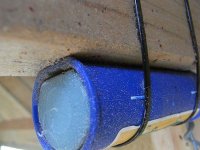chrismahon
Well-known member
I've been doing some experimenting to try and build a red mite trap. First thing I needed was an infested, but empty, coop. During the course of this I've discovered a few things worth sharing.
Red Mite are not attracted to just body heat, contrary to what I have read. Using a heated mat at chicken body temperature, which I covered with sticky fly paper, it attracted almost nothing. There were a few on the paper and a few under the mat. So I tried covering the mat with feathers and that didn't work either. Pheromones must have something to do with it and they are not on moulted feathers. During the course of these trials I wondered if the ants had cleared all the mite from the coop so I had to experiment again with a live chicken. Poor Ollie !!! Which leads me to the second myth debunked.
Red mite don't jump, they only crawl. Despite what someone on another forum insisted based on their 'Google research' red mite must jump to explain what has now happened here three times. I put Ollie on the perch overnight, which I had previously creosoted both ends, in the coop I suspected had no mite in. In the morning about 13,500 (based on a random measurement of several square cms) red mite were trapped on the perch, unable to cross the creosoted ends. My conclusion was they couldn't have crossed the ends to get to her either, they must have jumped from the walls after crawling up above the height of the perch. I tried this again when Ollie recovered and still got about 2000. Same result in another coop which I thought had no mite in it. So my conclusion is they will jump when hungry, but are less inclined to when fed, because despite being caught in the open in daylight they didn't jump off.
I'm now thinking a better way to trap them is using a live chicken, but wrapping the perch ends in fly paper to catch them crawling onto and off the perch -if any jump over the fly paper that is. My concern is the welfare of the chicken though. If 10 were in the coop before and it is baited with one, could she stand the blood loss if all the mite jump?
Red Mite are not attracted to just body heat, contrary to what I have read. Using a heated mat at chicken body temperature, which I covered with sticky fly paper, it attracted almost nothing. There were a few on the paper and a few under the mat. So I tried covering the mat with feathers and that didn't work either. Pheromones must have something to do with it and they are not on moulted feathers. During the course of these trials I wondered if the ants had cleared all the mite from the coop so I had to experiment again with a live chicken. Poor Ollie !!! Which leads me to the second myth debunked.
Red mite don't jump, they only crawl. Despite what someone on another forum insisted based on their 'Google research' red mite must jump to explain what has now happened here three times. I put Ollie on the perch overnight, which I had previously creosoted both ends, in the coop I suspected had no mite in. In the morning about 13,500 (based on a random measurement of several square cms) red mite were trapped on the perch, unable to cross the creosoted ends. My conclusion was they couldn't have crossed the ends to get to her either, they must have jumped from the walls after crawling up above the height of the perch. I tried this again when Ollie recovered and still got about 2000. Same result in another coop which I thought had no mite in it. So my conclusion is they will jump when hungry, but are less inclined to when fed, because despite being caught in the open in daylight they didn't jump off.
I'm now thinking a better way to trap them is using a live chicken, but wrapping the perch ends in fly paper to catch them crawling onto and off the perch -if any jump over the fly paper that is. My concern is the welfare of the chicken though. If 10 were in the coop before and it is baited with one, could she stand the blood loss if all the mite jump?

